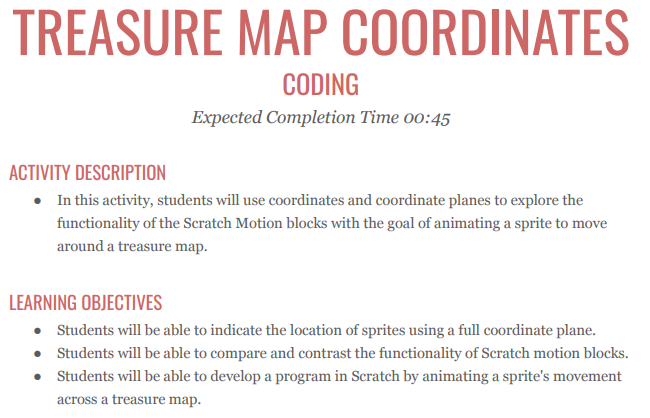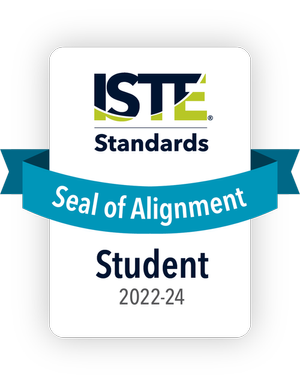Kentucky K-12 Computer Science Standards
Download a free 3-5 coding lesson that aligns with Kentucky computer science standards.
Codelicious Computer Science Curriculum
Codelicious Computer Science Curriculum is grade-level differentiated, aligns with Kentucky state standards, and is continually updated to reflect changes in computer science. Since computer science is more than just coding, Codelicious courses include coding, unplugged, digital citizenship, and STEM career lessons as well as hardware integrations.
Free Coding Lesson

COMPUTER SCIENCE LESSON PLAN
In this activity, students will use coordinates and coordinate planes to explore the functionality of the Scratch Motion blocks with the goal of animating a sprite to move around a treasure map. This lesson is built for grades 3 – 5 and introduces coding for kids: Scratch, a block based coding language.
The lesson PDF includes links to the appropriate materials and resources, a detailed procedure, activity tips, and a bonus challenge activity.
Kentucky Computer Science Standards
According to the Kentucky Department of Education, the state computer science vision is to learn new approaches to critical thinking and problem solving. The Kentucky standards for computer science emphasize the need to engage students in learning by implementing and integrating computer science instruction in the classroom. The Kentucky computer science standards were adapted from the CSTA standards, which are a national set of computer science standards.
The Kentucky state standards for computer science are organized by grade band: K-5, 6-8, and 9-12. The standards include five Essential Concepts with associated subconcepts:
-
Networks and the Internet
-
Network Communication and Organization
-
Cybersecurity
-
-
Data and Analysis
-
Storage
-
Collection, Visualization, and Transformation
-
Inference and Models
-
-
Algorithms and Programming
-
Algorithms
-
Variables
-
Control
-
Modularity
-
Program Development
-
-
Impacts of Computing
-
Culture
-
Social Interactions
-
Safety, Law, and Ethics
-
-
Computing Systems
-
Devices
-
Hardware and Software
-
Troubleshooting
-
Furthermore, the Kentucky Academic Standards for Computer Science progression chart shows at a quick glance what students should know by the end of each grade band. The chart describes student proficiency indicators for each concept and subconcept within the computer science standards.
-
Empowered Learner – Students leverage technology to take an active role in choosing, achieving and demonstrating competency in their learning goals, informed by the learning sciences.
-
Digital Citizen – Students recognize the rights, responsibilities and opportunities of living, learning and working in an interconnected digital world, and they act and model in ways that are safe, legal and ethical.
-
Knowledge Constructor – Students critically curate a variety of resources using digital tools to construct knowledge, produce creative artifacts and make meaningful learning experiences for themselves and others.
-
Innovative Designer – Students use a variety of technologies within a design process to identify and solve problems by creating new, useful or imaginative solutions.
-
Computational Thinker – Students develop and employ strategies for understanding and solving problems in ways that leverage the power of technological methods to develop and test solutions.
-
Creative Communicator – Students communicate clearly and express themselves creatively for a variety of purposes using the platforms, tools, styles, formats and digital media appropriate to their goals.
-
Global Collaborator – Students use digital tools to broaden their perspectives and enrich their learning by collaborating with others and working effectively in teams locally and globally.
The Kentucky computer science standards and the Kentucky technology standards are complementary of one another. The computer science standards are meant to explicitly teach the subject matter of computer science. The technology standards are meant to be integrated into other subject areas, such as math, ELA, and social students. Additionally, the technology standards are meant to teach students digital citizenship and the responsible use of technology.
What Is Computer Science Education
The importance of computer science in education is clear as technology continues to advance. According to the Bureau of Labor Statistics, employment in computer and information technology occupations is projected to grow 11% from 2019 to 2029. Given this, shouldn’t we equip our students with these skills starting at a young age?
Currently, computer science standards span from K-12; computer science education begins with the Kentucky kindergarten state standards and goes all the way until AP Computer Science in high school. Most of these courses consist of a coding component, where students learn programming skills. The basic building blocks of coding such as loops, functions, and conditionals can be taught in elementary school and applied to more complex languages as students progress in their K-12 journey. As students attempt more advanced projects, such as developing websites, programs, and games, they are motivated to connect with their world and empowered to expand their skills.
Computer science education, however, is not only about coding. K 12 computer science also focuses on developing 21st century skills, such as the 4 C’s (communication, collaboration, computational thinking, and creativity). A strong foundation in these computer science skills will serve them well for years to come, regardless of the path they decide to pursue. The Kentucky computer science standards are designed to encourage multidisciplinary learning. For example, Kentucky academic standards for technology and computer science can be integrated into other core subject areas, like Kentucky math standards, Kentucky science standards, Kentucky social studies standards, and even national core arts standards. Whether you teach the Kentucky common core standards or the national music standards, there is always room for computer science integration.
Title I
If you are a Title I school in Kentucky, you may consider using your federal funds to purchase computer science curriculum.
WHAT IS TITLE I FUNDING?
Title I funds programming for low-income students. The money must go toward helping these students meet academic state standards. The amount of Title I funding distributed across the nation is available through the DOE website (most recently updated in 2017).
WHAT CAN TITLE I FUNDS BE SPENT ON?
Title I usage is based on the makeup of your student body. If 40% or more of your school’s students come from low-income families, Title I funds must be used on school-wide initiatives. These are known as Title I schools. If less than 40% of your school’s students come from low-income families, Title I funds must be used for programming that targets low-income students. It is important to note that Title I funds must go directly to low-income students, and the programs/materials cannot have been used in other classrooms first.
K 12 Computer Science Curriculum
Codelicious provides full-year K-12 computer science curriculum that aligns with the Kentucky computer science standards. In addition, all Codelicious courses have been awarded the ISTE Seal of Alignment. This seal means Codelicious aligns with the ISTE standards and provides a high-quality, standards-aligned learning experience that enhances students’ digital age skills. The curriculum offers grade level differentiated learning pathways, aligns with all state and national computer science standards, and is continually updated to reflect changes in computer science. Codelicious courses are customized to districts’ unique instructional strategy for computer science integration. This can mean incorporating computer science into an existing class period, adding to a specials rotation, or introducing a stand alone class. Courses are delivered with instructional resources teachers need to feel confident teaching computer science in K-12 while meeting the Kentucky teaching standards.
Our computer science curriculum for K-2 empowers you to engage your students with courses that fuel their interest. Coding lessons use ScratchJr, an introductory block coding language, perfect for emergent and early readers. In grades 3-5, inspire your students with courses that spark their creativity. Coding lessons use Scratch, a block based coding language, ideal for the transitional and fluent reader.
Our computer science curriculum middle school (6-8) helps you motivate your students with courses that connect to their world. Coding lessons use line based languages JavaScript, HTML, CSS, and Java to explore programming options.
Our computer science high school curriculum (9-12) helps you empower your students with courses that expand their skills. Coding lessons use JavaScript, Java, Python, and Godot to develop websites, programs, and games.
Explore our full k-12 computer science education course offering on our courses page. If any of these course options interest you, schedule a 30 minute call with one of our curriculum experts. Find the curriculum that will support every teacher as they inspire every student.
Computer Science Careers
After being introduced to computer science curriculum in K-12, students may be inspired to continue their computer science education. The Kentucky academic standards for career studies might allow students to explore computer science even more. On a professional level, companies are recruiting for computer science degree jobs in cloud computing, app development, and statistical analysis. On an individual level, computational thinking, problem solving, and relationship building are all deeply influenced by computer science. This understanding of computer science jobs leads to much broader applications. you don’t necessarily need a degree in computer science; anyone that uses technology to solve problems can be considered a computer scientist!
Introducing computer science in the K-12 experience opens doors for students to pursue a computer science degree in college. The top computer science colleges in Kentucky, including University of Kentucky vs, Berea College, and Centre College offer concentrations in various areas of computer science, like computer information systems, information technology, computer software and applications, and computer systems networking. The reality is, though, students do not need to attend a university to pursue these computer science majors. Even non-STEM majors, like business, biology, and English use computer science skills to communicate ideas. When students look at a career choices curriculum, they’ll find that computer science education can open doors in many career paths.
Likewise, computer science skills taught in K-12 can be applied directly to any career students pursue after high school. Computational thinking, problem solving, and teamwork can be applied in trades (like electrician, plumber, and HVAC) and other positions (like retail, restaurants, and reception).
Codelicious spotlights the many forms of computer science careers in our My STEM Career. In these interviews, hear from professionals, students, and teachers as they share how they built confidence in their computer science skills. Two particularly interesting interviews include Will Muto, a Product Technical Director at Industrial Light and Magic, who worked on Star Wars films, and Alia Enos, Software Developer II at 343 Industries, who works on the Halo video game series.
Free Coding Lesson

COMPUTER SCIENCE LESSON PLANS
In this activity, students will use coordinates and coordinate planes to explore the functionality of the Scratch Motion blocks with the goal of animating a sprite to move around a treasure map. This lesson is built for grades 3 – 5 and introduces coding for kids: Scratch, a block based coding language.
The lesson PDF includes links to the appropriate materials and resources, a detailed procedure, activity tips, and a bonus challenge activity.

